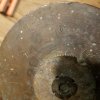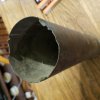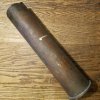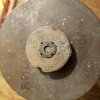This image shows a case and projectile being loaded as a single element, but another loader is holding just the case. Is the projectile rammed in separately which is not as shown or are the two put together as it seems here ? The case has a cap and if removed prior to loading then assembling the round prior to loading would be easy. Or is one just placed in front of the other and both pushed in at the same time. Can any one clarify this ?
British Ordnance Collectors Network
You are using an out of date browser. It may not display this or other websites correctly.
You should upgrade or use an alternative browser.
You should upgrade or use an alternative browser.
12 Pr 12wht Question, semi fixed or separate loading ?
- Thread starter Gspragge
- Start date
Tony Williams
Well-Known Member
Wonder if the small dog is the Detachment Commander?
Doubt it - can't see any rank badges.
glevum
Well-Known Member
The 12 Pr 12 cwt AA gun which was a conversion of the Coast Artillery gun is listed by Hogg in "British Artillery Weapons and Ammunition 1914-1918" as having fixed or separate loading QF cased ammunition. The case length differs Separate is 15.4" fixed is 16" long.
After the end of the war in 1918 the AA guns were converted back to the coast defence role.
Could this be a coast defence gun fitted to the trawler at the start of WW2 using what ever stocks of ammunition were available?
After the end of the war in 1918 the AA guns were converted back to the coast defence role.
Could this be a coast defence gun fitted to the trawler at the start of WW2 using what ever stocks of ammunition were available?
I'm sure that is, it looks like it is a fair bit wider than the top of the case or is it just the image. If it clips on and is wider and covers the top & exterior of the case then it would have to be removed before loading and perhaps the projectile could be placed into the case, making it a semi-fixed round. Are there protrusions that fit into the notches on the top of the case ? It that a piece of wood attached to the cap ? I thought it was something that fit into the top and dissipated upon firing, but this certainly looks different.
The ww1 image shows an internal cap, but by ww2 perhaps it was different, or there is an external cap removed before firing and an internal that stays in, which then seems to indicate separate loading in some fashion.
Certainly the ww2 primer in mine is different than the ww1 version.
A manual with the loading drill would answer the question ~
The ww1 image shows an internal cap, but by ww2 perhaps it was different, or there is an external cap removed before firing and an internal that stays in, which then seems to indicate separate loading in some fashion.
Certainly the ww2 primer in mine is different than the ww1 version.
A manual with the loading drill would answer the question ~
Attachments
Last edited:
These are found like this in a copper transport case (the wood rotted away) primer/shell casing/cordite inside closed up with a (cotton?) patch extruding primer in a wooden base form and the top cover on the other side to prevent damage a it is for sure for the separate casing pic 1 No trace of a german haube type top like pic 2 this one must be removed. Pic 3 is only to let you see the drill version of the 12 pdr 12 cwt wood filled with a rod through bot sides of the casing.
The transport cover normally fits thight but the top of the case is not perfect.



The transport cover normally fits thight but the top of the case is not perfect.



Maybe they stopped using the internal cap and went to this form. How much cotton wad was there, my case seemed to have a great deal of cotton cheese cloth like material in it. Certainly if the internal plug was being used you would have found it. Are these ww2 casings.
as I understand it the shell was rammed by the case if seperate loading so there must have been a a solid lid. Is the picture showing the shell being rammed but not fixed in the case? whos got the gun manual? The fixed cases have crimp grooves about 10mm below the top are slightly longer and do still have a hint of a neck when fired.
Dredging this topic back up since I've received my first 12 per external primer. I gather mine is a separate loading since it has no crimping groove. 1918, 12Cwt, reloaded in 10/39. My question would be this; what are the cuts in the mouth, as I see they are in 2pounder's S/L casing and Michael's also. Thanks, Bruce.
Attachments
Last edited:
The gun was used through both the first, and second, world wars, so the cases for the S/L guns turn up here in England quite frequently at antique fairs and militaria shows. However, they are usually without the protruding primer, as it is easier to make them sit firmly without it.
The AA gun case for the fixed round seems to be much scarcer, as I have only seen two for sale in the past 10 years.
Roger.
The AA gun case for the fixed round seems to be much scarcer, as I have only seen two for sale in the past 10 years.
Roger.
The cases shown up in Canada once in a while also, but only as far as I've seen the notched kind. My two projectiles have no crimp groove and I imagine
that kind of projectile is rare, does any one have one to show ? Certainly there is so little exposed body below the band and no crimp groove
that the usual types would never go in a case & be crimped.
that kind of projectile is rare, does any one have one to show ? Certainly there is so little exposed body below the band and no crimp groove
that the usual types would never go in a case & be crimped.










